The Brown Fish Owl stands out as a unique and fascinating creature in the vast world of avian species. Boasting an impressive wingspan and captivating eyes, this bird is certainly one to watch. Found predominantly across parts of Asia, these owls have adapted perfectly to their environment and lifestyle.
As their name suggests, Brown Fish Owls are known for their distinct diet, primarily of aquatic creatures. They’ve developed an intriguing hunting technique distinguishing them from other owl species. They swoop near water bodies at remarkable speeds to snatch unsuspecting fish.
In this article, I’ll dive deeper into these fascinating birds’ lives – exploring everything from their habitat preferences to their breeding habits. There’s much more to discover about the Brown Fish Owl than meets the eye!
Habitat and Distribution of the Brown Fish Owl
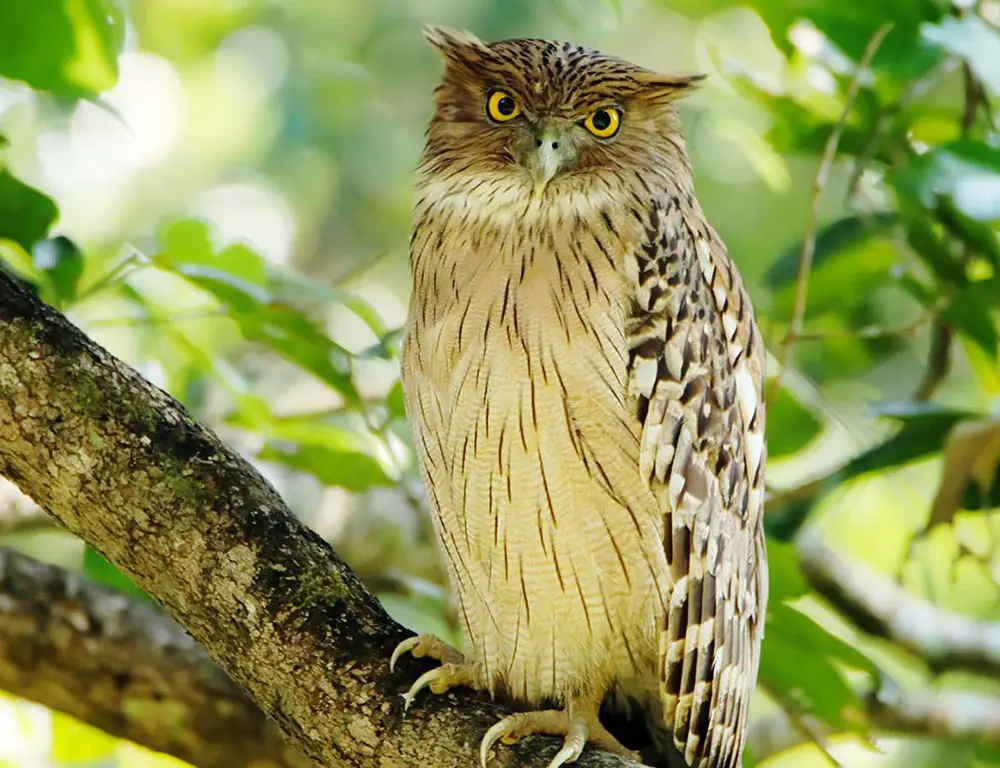
With its remarkable adaptability, the Brown Fish Owl has established its presence across various habitats in the warmer regions of Asia.
Here’s a closer look at its habitat and distribution:
Regions
The Brown Fish Owl is predominantly found in the Indian Subcontinent and enjoys widespread distribution across most parts of the region.
Additionally, it inhabits Southeast Asia, primarily favoring forested areas. In the Middle East, particularly in countries like Turkey and Iran, it tends to be mainly concentrated along river valleys.
Habitats
These owls exhibit remarkable versatility when it comes to habitat selection. They inhabit diverse locales, including dense forests, rocky terrains, lowlands, and flat areas near bodies of water such as rivers, lakes, and marshes.
Despite being primarily associated with watery habitats due to their piscivorous diet, they can also be found in areas far from water sources.
Altitude
An exciting aspect of the Brown Fish Owl’s habitat preference is its ability to inhabit a wide range of altitudes. While they are commonly observed in lowlands and flat areas near water bodies, they can also nest at higher altitudes, reaching up to 2000 meters.
This adaptability showcases their resilience in diverse environments.
Dietary Adaptation
The affinity of Brown Fish Owls for watery habitats is closely linked to their dietary habits.
Their primary food sources consist of fish and crustaceans, for which they have evolved specialized hunting adaptations, including long legs and powerful talons adept at snatching prey from the water.
Physical Characteristics of the Brown Fish Owl
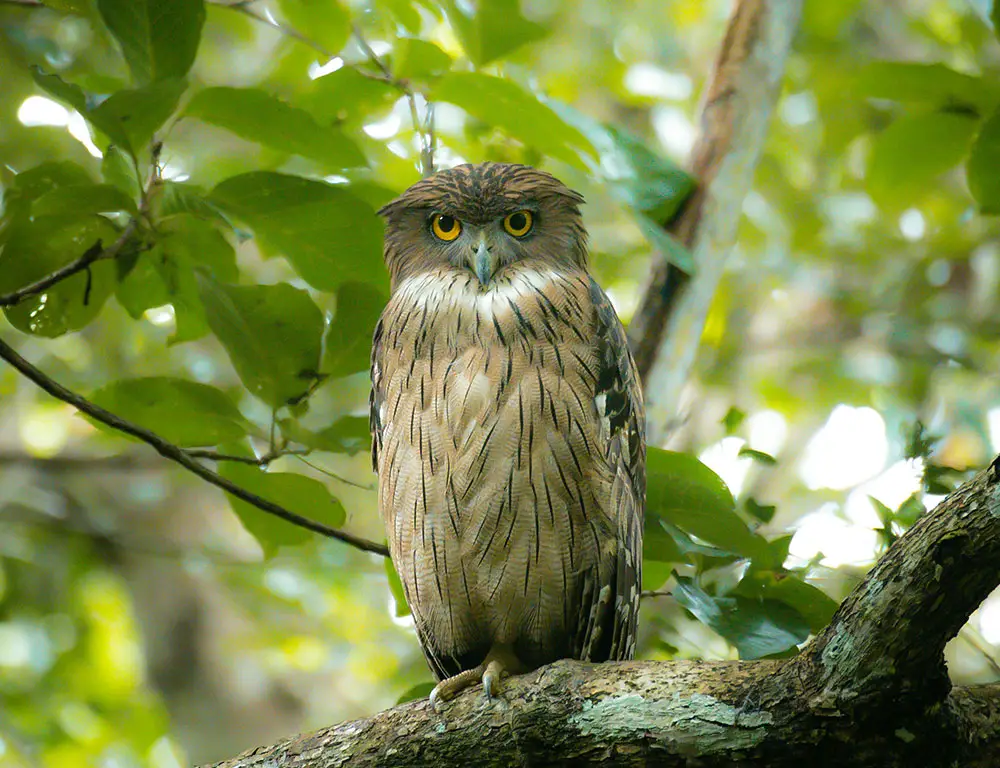
The Brown Fish Owl (Bubo zeylonensis) possesses a striking set of physical characteristics that are finely tuned for its lifestyle and hunting behaviors:
Size
This owl commands attention with its size, measuring between 20 to 23 inches in height and weighing approximately 2.1 to 4.6 pounds. Its substantial build makes it one of the larger owl species.
Wings
Sporting broad wings spanning around 18 inches across, the Brown Fish Owl is well-equipped for efficient flight and precise maneuvers, particularly during hunting excursions.
Coloration
As its name suggests, the Brown Fish Owl is adorned with various brown hues, ranging from light to dark shades across its plumage. Complementing this base color are streaks of white or off-white, enhancing its overall appearance.
Eyes
One of its most captivating features is its large, yellowish-orange eyes, encircled by a noticeable facial disk. This unique trait contributes to its mesmerizing gaze and enhances its ability to detect prey, especially in low-light conditions.
Legs and Feet
Unlike many other owl species, the Brown Fish Owl boasts feathered legs but bare feet, a feature that is well-suited for its semi-aquatic lifestyle. With sharp talons adapted for grasping prey, it excels as a formidable hunter on land and water.
Bill
A distinctive characteristic of the Brown Fish Owl is its hooked bill, which plays a crucial role in capturing and consuming prey. This specialized bill structure aids in seizing and tearing apart fish and other aquatic prey items, highlighting its adaptation to a piscivorous diet.
Diet and Feeding Habits of the Brown Fish Owl
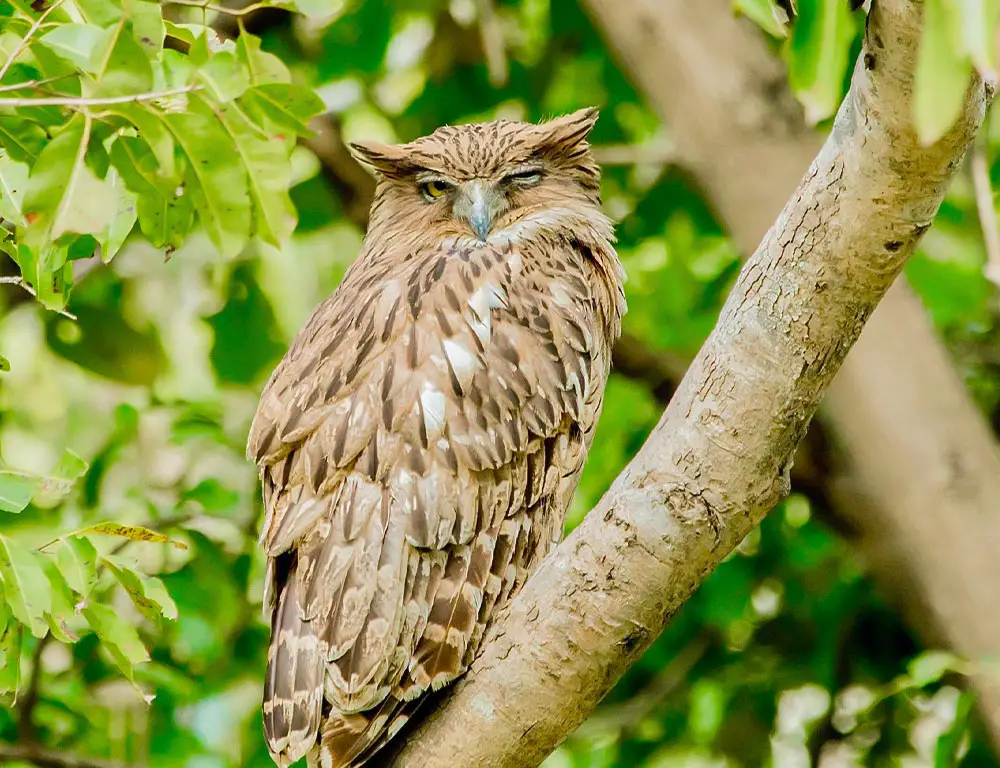
The diet and feeding habits of the Brown Fish Owl (Bubo zeylonensis) are fascinating aspects of its behavior, showcasing its adaptability and hunting prowess:
Primary Diet
As their name suggests, Brown Fish Owls primarily feed on aquatic prey, with fish comprising a significant portion of their diet. They are skilled hunters capable of snatching fish directly from the water using their sharp talons.
Adaptability
One notable feature of their feeding habits is their flexibility in diet. In times of scarcity or when fish are less abundant in their habitat, Brown Fish Owls readily switch to alternative prey sources.
This adaptability enables them to thrive in diverse environments ranging from dense forests to urban settings.
Common Prey Items
- Fish: Constituting around 60% of their diet, various species of fish found in rivers, lakes, and ponds serve as the primary food source for Brown Fish Owls.
- Small Mammals: When fish are scarce, Brown Fish Owls turn to small mammals such as rodents (rats and mice) for sustenance, comprising approximately 25% of their diet.
- Birds: Smaller bird species also form part of their diet, particularly during food scarcity, accounting for about 15% of their food intake.
Hunting Technique
Brown Fish Owls employ a stealthy hunting technique, perching silently near water bodies and scanning the surroundings for movement. Once prey is detected, they execute swift swoops to catch it by surprise.
Occasionally, they may wade into shallow waters to capture nearby prey items.
Variability in Diet
It’s essential to note that the percentages of food types in their diet can vary based on geographical location and seasonal changes, reflecting the adaptability of these owls to different environmental conditions and prey availability.
Reproduction and Nesting Habits of the Brown Fish Owl
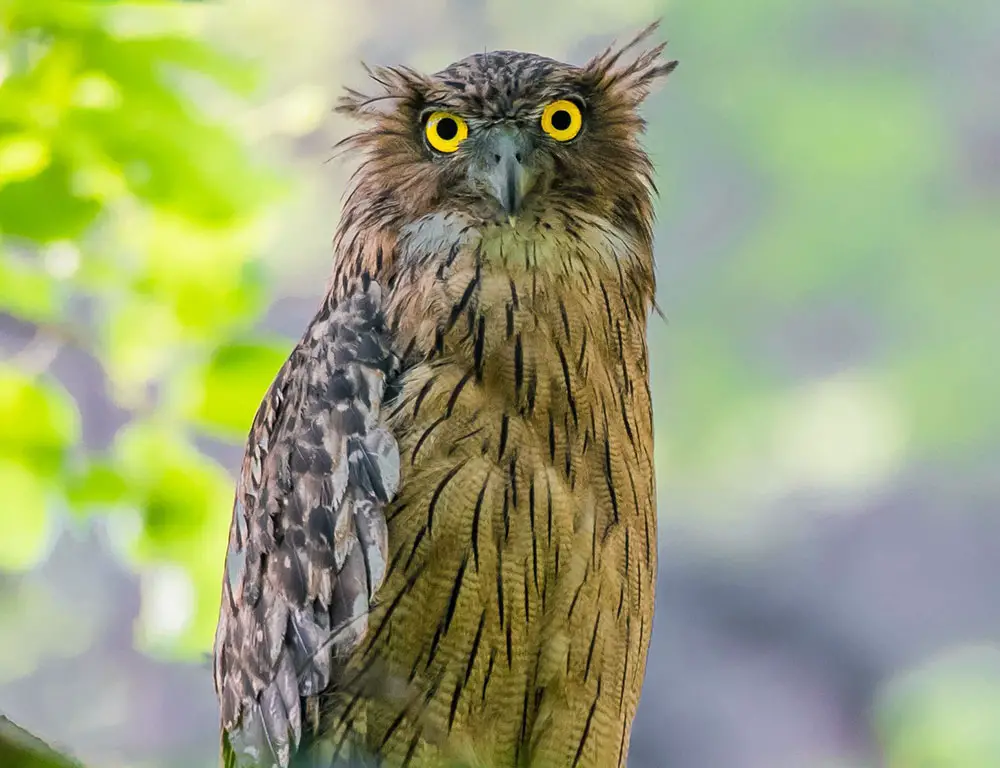
Reproduction and nesting behaviors of the Brown Fish Owl (Bubo zeylonensis) provide insights into the intricacies of their family life and breeding strategies:
Monogamy
Brown Fish Owls are monogamous birds, forming long-term pair bonds with a single mate for life. This commitment ensures cooperation between partners in raising offspring and maintaining territory.
Mating Season
The mating season typically occurs between January and March, marked by the haunting hoots of males as they court potential mates. This period is crucial for pair formation and initiation of the breeding cycle.
Nesting Sites
Female Brown Fish Owls, including old tree hollows, rock caves, or disused buildings, select nesting sites to lay their eggs. These locations provide shelter and protection for the developing eggs and nestlings.
Clutch Size
The average clutch size ranges from one to two eggs, although occasionally, only one egg may be laid per clutch. This variability in clutch size may depend on factors such as food availability and environmental conditions.
Incubation
The incubation lasts approximately 35 days, during which the female is responsible for warming and protecting the unhatched eggs. Meanwhile, the male contributes by providing food to sustain the female during this critical period.
Parental Care
Upon hatching, both parents feed and care for the chicks until they are ready to fledge at around 60 days old.
Despite fledging, the young owls remain close to the parental territory for several more months, gradually gaining independence and honing their hunting skills under the guidance of their parents.
Brown Fish Owl Conservation Status
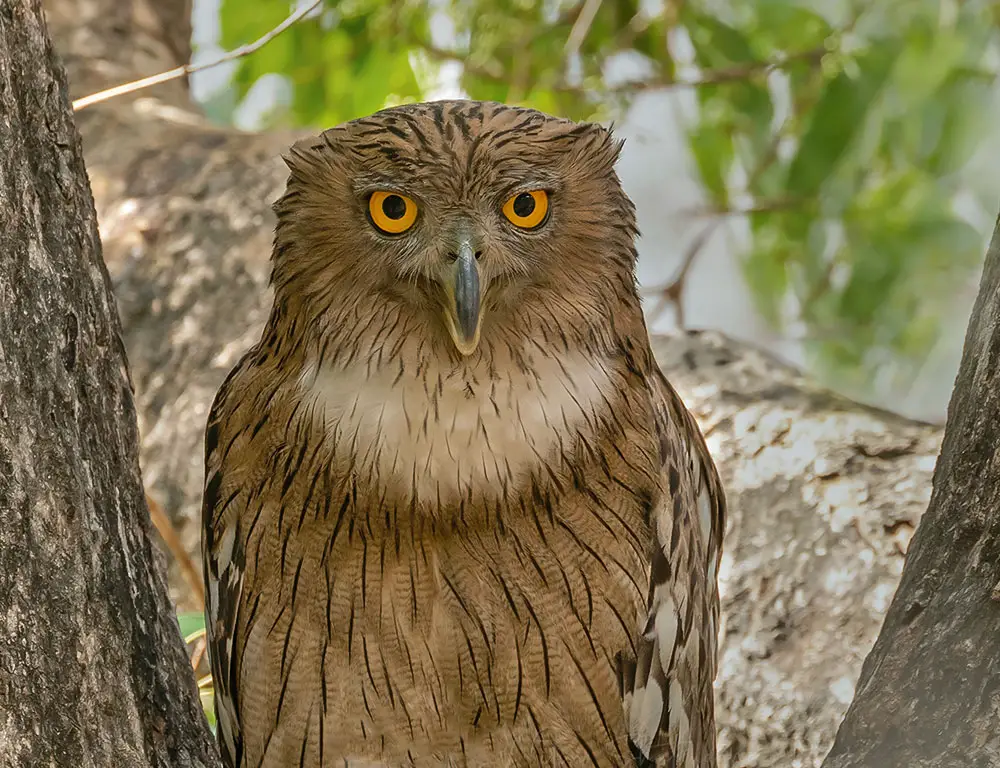
The conservation status of the Brown Fish Owl (Bubo zeylonensis) is currently classified as “Least Concern” by the International Union for Conservation of Nature (IUCN).
However, this designation does not imply that the species is free from threats or that conservation efforts are unnecessary.
Here are some key points regarding the conservation status of the Brown Fish Owl:
Threats
- Habitat Destruction: The ongoing destruction and fragmentation of forests, primarily for timber extraction and agricultural expansion, pose a significant threat to Brown Fish Owl populations. Loss of suitable habitat reduces nesting sites and food sources, ultimately impacting survival.
- Human Persecution: like many other owl species, Brown Fish Owls are sometimes persecuted by humans due to superstitions or fears. This persecution can harm individuals or disrupt nesting activities, further affecting population dynamics.
- Pesticide Pollution: Pesticide contamination in water bodies where fish—the primary prey of Brown Fish Owls—are abundant directly threatens their health and survival. Accidental ingestion of contaminated prey can lead to poisoning and mortality among owl populations.
Conservation Efforts
- Habitat Protection: Conservation efforts should focus on preserving and restoring the habitats essential for Brown Fish Owl survival. This includes protecting forested areas and establishing wildlife corridors to facilitate movement between fragmented habitats.
- Community Engagement: Engaging local communities in conservation initiatives and raising awareness about the ecological importance of Brown Fish Owls can foster greater appreciation and support for their protection.
- Mitigation Measures: Implementing measures to reduce human-wildlife conflicts, such as minimizing pesticide use near owl habitats and implementing wildlife-friendly infrastructure to prevent collisions with vehicles, can help mitigate threats to Brown Fish Owls.
Sustainable Practices
Promoting sustainable land-use practices, such as agroforestry and organic farming, can help minimize habitat degradation and pesticide pollution, benefiting Brown Fish Owl populations and other wildlife species.
Conclusion
My deep dive into the world of the Brown Fish Owl has been a fascinating journey. I’ve come away with an enriched understanding of this nocturnal creature and its intriguing characteristics. Let’s take a moment to recap some key points.
Firstly, it’s worth noting that the Brown Fish Owl is unique amongst its owl counterparts due to its distinctive fishing skills. This bird has mastered catching fish in various bodies of water, making it stand out in the owl family.
Secondly, their range and habitat are extensive, spreading across many parts of Asia. From dense forests to open marshlands, they’ve adapted to various environments.
Here’s a quick look at some numbers:
| Statistic | Value |
|---|---|
| Average Lifespan | 15 years |
| Wingspan Range | 37-45 inches |
| Weight Range | 2-4 lbs |
While these figures give us an insight into the physical attributes of these owls, remember that each individual may vary slightly depending on environmental factors and genetic traits.
Remember:
- The Brown Fish Owl primarily feeds on fish and crustaceans.
- They’re known for their distinctive hooting calls.
- Breeding season usually happens between December and March.
I hope this article has given you a comprehensive overview of the Brown Fish Owl. There’s much more than meets the eye regarding this species – from their specialized hunting techniques to their wide-ranging habitats across Asia.
My exploration into this captivating creature has undoubtedly left me eager to learn about other unique wildlife species around our globe!